Indirect Pulp Capping
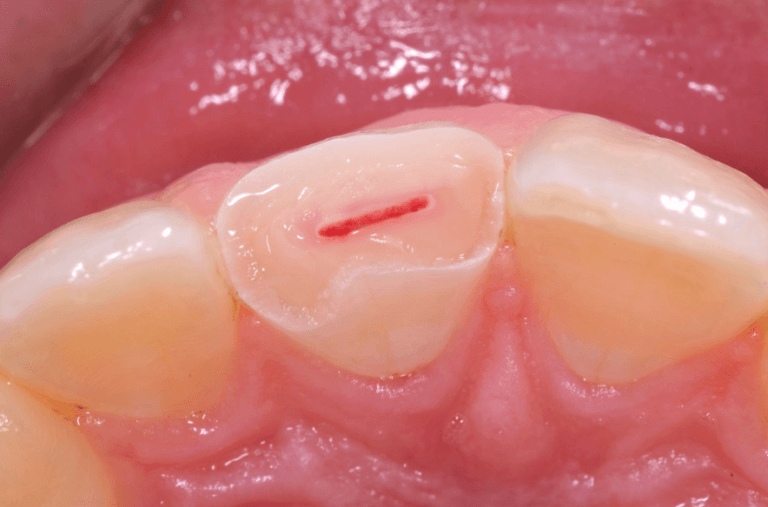
What Is Indirect Pulp Capping?
Your dental health is a crucial part of your overall well-being, and it’s essential to stay informed about the various procedures and treatments available to maintain a bright and healthy smile. One such procedure that you may have heard of, but might not be entirely familiar with, is “Indirect Pulp Capping.”
The dental pulp is the soft innermost tissue located within a tooth. It consists of sensitive nerve fibers, blood vessels, and connective tissues. The dental pulp plays a vital role in maintaining the health of the tooth by nourishing it, transmitting sensory information (such as temperature and pain sensations), and helping with tooth development. When the dental pulp becomes infected or damaged due to factors like tooth decay or tooth trauma, it may require treatment such as direct or indirect dental pulp capping, or removal through procedures like root canal treatment to preserve the tooth’s function and structure.
Indirect Pulp Capping is a dental pulp capping procedure aimed at saving a tooth when it’s been affected by decay or damage, but the infection hasn’t yet reached the vital pulp chamber. In simpler terms, it’s a dental intervention that helps protect your tooth’s innermost core, known as the dental pulp, without having to perform a full-scale root canal. During this procedure, after caries excavation, a dental biomaterial is placed in the deep areas of the dentin just above the dental pulp. The aim of indirect pulp capping is to promote pulp healing and a mineralized tissue barrier layer above the dental pulp. Successful application of this approach avoids the need for further and more extensive treatment such as root canal treatment or tooth removal.
Before deciding on whether Indirect Pulp Capping are right for you, there are some things you should know:
- Who Needs Indirect Pulp Capping?
- What Are The Advantages Of Indirect Pulp Capping?
- What Are Indications for Indirect Pulp Capping?
- What Are Contraindications for Indirect Pulp Capping
- What Are The Alternative Treatments If I Do Not Choose Indirect Pulp Capping?
- How Much Does Indirect Pulp Capping Cost?
- What Are The Steps In The Indirect Pulp Capping Procedure?
- Can I Have Indirect Pulp Capping If I Am Pregnant?
- What Are Common Problems With Indirect Pulp Capping?
If you have any further questions about Indirect Pulp Capping or other dental services offered at Atlas Dental, please contact us.

Free phone consultation
Have questions about Dental Pulp Capping? Schedule a free phone consultation with our Toronto dentist.

5 star google reviews
Our patients love us! See for yourself why more and more people are choosing Atlas Dental for Dental Pulp Capping.

Book Emergency tooth filling
Do you think you have cavities and need a Dental Pulp Cap? Book an emergency tooth filling online.
Who Needs Indirect Pulp Capping?
Indirect Pulp Capping is a dental procedure that can be a game-changer for individuals facing specific dental issues. While not everyone will require this treatment, it serves a critical role in preserving teeth when certain conditions arise. So, who are the individuals who might benefit from Indirect Pulp Capping?
- Early-Stage Dental Decay: One of the primary candidates for Indirect Pulp Capping is someone with early-stage dental decay. When a cavity has just started to form and hasn’t reached the dental pulp yet, this procedure can be used to arrest the decay’s progress. By removing the damaged or decayed portion of the tooth and placing a protective material over it, dentists can prevent the need for a more invasive procedure like a root canal.
- Deep Fillings: Sometimes, when you have a deep filling or a large restoration, there’s a risk that the dental pulp could become irritated or even exposed during the filling process. In such cases, your dentist might recommend Indirect Pulp Capping to safeguard the pulp and prevent any further complications.
- Trauma or Injury: Accidents can happen, and dental trauma or injury may occur. If a tooth sustains a crack or fracture, it can jeopardize the dental pulp’s health. Indirect Pulp Capping may be considered to protect and preserve the pulp in such cases, avoiding the need for more extensive treatments.
- Symptomatic Teeth: Sometimes, a tooth can become symptomatic without a clear cause. You might experience discomfort or sensitivity without apparent dental decay or damage. In such instances, Indirect Pulp Capping can be a diagnostic tool. If the symptoms resolve after the procedure, it suggests that the pulp was the source of the problem, and further treatment can be planned accordingly.
- Preservation of Healthy Teeth: In certain cases, dentists may opt for Indirect Pulp Capping as a proactive measure. For instance, if a tooth requires a large filling due to a cavity but the pulp remains healthy, this procedure can be used to protect the pulp from future harm and prolong the tooth’s lifespan.
It’s essential to note that the decision to undergo Indirect Pulp Capping is made after a thorough examination and assessment by a dental professional. Your dentist will consider the specific circumstances of your dental issue and determine whether this procedure is suitable for your case. Choosing this minimally invasive option over more extensive treatments can often save your natural tooth and alleviate the need for more complex dental procedures. If you have further questions about Indirect Pulp Capping, please contact us.
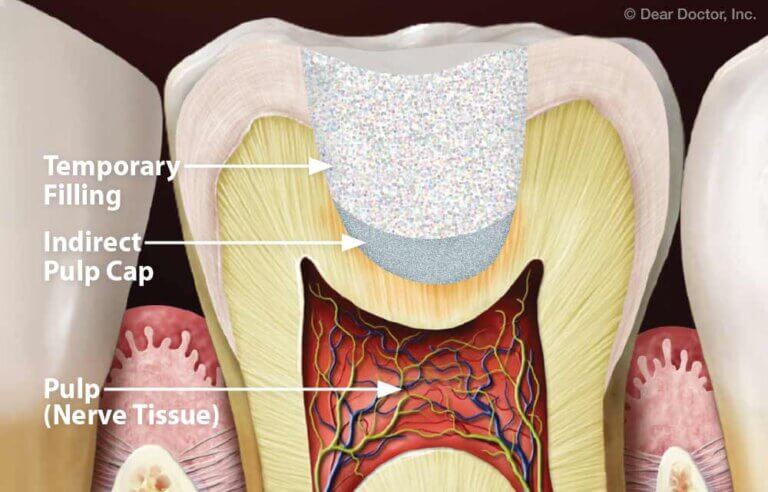
What Are The Advantages Of Indirect Pulp Capping?
Indirect Pulp Capping is gaining popularity in the world of dentistry for several compelling reasons. It offers numerous advantages, making it an attractive option for preserving and protecting your teeth when facing specific dental issues. Here are the key benefits of this procedure:
- Preservation of Natural Teeth: Perhaps the most significant advantage of Indirect Pulp Capping is its ability to save natural teeth. By stopping the progression of dental decay or damage without resorting to tooth extraction or a full root canal, it helps maintain the integrity and function of your original tooth.
- Minimally Invasive: Unlike root canals or tooth extractions, which involve more extensive procedures, Indirect Pulp Capping is minimally invasive. It requires less removal of tooth structure, resulting in a quicker and more comfortable recovery for the patient.
- Pain Reduction: Indirect Pulp Capping is often performed when a tooth becomes symptomatic due to irritation or early infection of the dental pulp. By addressing the issue at this stage, the procedure can alleviate pain and discomfort, providing relief to the patient.
- Preserves Dental Function: Your natural teeth are designed to function optimally, allowing you to bite, chew, and speak without any issues. Indirect Pulp Capping helps maintain these functions, ensuring you can continue to use your tooth as you normally would.
- Cost-Effective: Compared to more extensive dental procedures like root canals or tooth replacements (such as dental implants), Indirect Pulp Capping is often a cost-effective option. It saves you money while still addressing the dental problem effectively.
- Less Time-Consuming: The procedure is relatively quick and typically requires fewer dental visits than complex treatments like root canals. This means less time spent in the dental chair and a quicker return to your regular routine.
It’s important to remember that the suitability of Indirect Pulp Capping depends on the specific circumstances of your dental issue and should be determined by a qualified dentist. If you’re experiencing dental pain, discomfort, or have concerns about your oral health, consult with your dentist to explore the best treatment options, which may include this minimally invasive and highly advantageous procedure. If you have further questions about Indirect Pulp Capping, please contact us.
What Are Indications for Indirect Pulp Capping?
Indirect Pulp Capping is recommended in specific situations where it can effectively preserve dental pulp health and avoid more invasive treatments like root canals or extractions. The primary indications for Indirect Pulp Capping include:
- Early-Stage Dental Decay: When decay has penetrated the enamel and dentin layers of a tooth but hasn’t reached the dental pulp, Indirect Pulp Capping may be considered. It’s used to halt the progression of decay and protect the dental pulp from infection.
- Deep Fillings: In cases where a deep filling is necessary due to a cavity or dental restoration, there is a risk of irritating or exposing the dental pulp. Indirect Pulp Capping can be employed to protect the pulp and prevent complications.
- Trauma or Injury: Dental trauma, such as a tooth fracture or impact, can damage a tooth and potentially affect the dental pulp. If the pulp is still vital, Indirect Pulp Capping may be used to safeguard it from further harm.
- Symptomatic Teeth: When a tooth becomes symptomatic, causing pain or discomfort without clear evidence of dental decay or damage, Indirect Pulp Capping can serve as both a diagnostic and treatment tool. If the symptoms resolve after the procedure, it suggests that the dental pulp was the source of the problem, and further steps can be taken accordingly.
- Preservation of Healthy Teeth: In some cases, dentists may recommend Indirect Pulp Capping as a proactive measure to protect a healthy tooth that requires a substantial filling. This can help prevent future complications and extend the tooth’s lifespan.
It’s important to emphasize that not all dental situations are suitable for Indirect Pulp Capping. The decision to use this procedure is made after a thorough examination and assessment by a qualified dentist who will consider the specific circumstances of the patient’s dental issue. If you suspect that you may need dental treatment or have concerns about your oral health, it’s crucial to consult with a dentist. If you have further questions about Indirect Pulp Capping, please contact us.
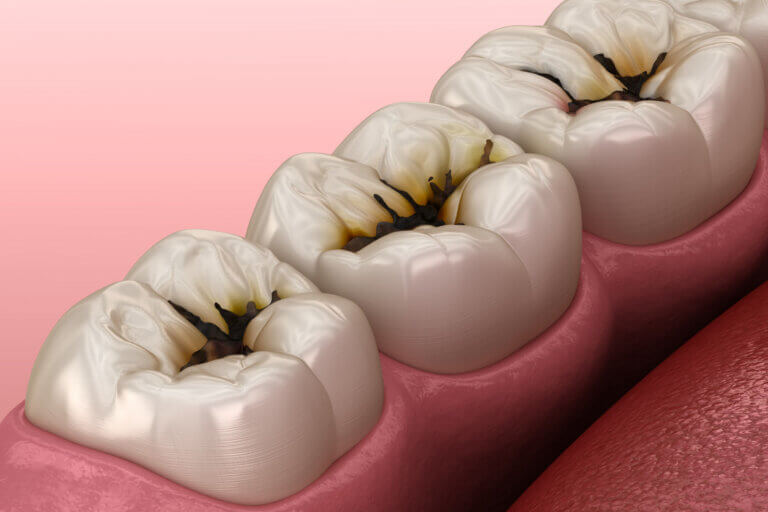
What Are Contraindications for Indirect Pulp Capping
Indirect Pulp Capping is a dental procedure that can be highly beneficial in preserving tooth health in specific cases. However, there are also contraindications—circumstances or conditions in which this procedure may not be recommended. Dentists carefully assess each patient’s unique situation to determine whether Indirect Pulp Capping is appropriate. Here are some common contraindications:
- Advanced Dental Decay: If the dental decay has reached a more advanced stage and has already affected the dental pulp extensively, Indirect Pulp Capping may not be effective. In such cases, a root canal procedure may be necessary to address the infection and save the tooth.
- Signs of Pulp Infection: If there are clear signs of dental pulp infection, such as swelling, pus drainage, or severe pain, Indirect Pulp Capping may not be suitable. A root canal or tooth extraction may be necessary to address the infection and relieve the patient’s symptoms.
- Pulpal Necrosis: If the dental pulp is already non-vital or necrotic, meaning it is not capable of healing or responding to treatment, Indirect Pulp Capping is unlikely to be successful. In such cases, more extensive dental procedures are needed.
- Insufficient Tooth Structure: If the tooth lacks sufficient remaining healthy structure to support the restoration or seal required for Indirect Pulp Capping, alternative treatments may be more appropriate. Inadequate tooth structure can compromise the long-term success of the procedure.
- Previous Failed Pulp Capping: If a patient has previously undergone Indirect Pulp Capping on the same tooth, and it was unsuccessful in preserving dental pulp health, repeating the procedure may not be advisable.
It’s important to note that the determination of whether Indirect Pulp Capping is contraindicated in a particular case should be made by a qualified dentist. Dentists consider various factors, including the patient’s dental condition, overall health, and the specific circumstances of the tooth in question when making this decision. If Indirect Pulp Capping is not recommended, alternative treatments will be discussed to address the patient’s dental needs effectively. If you have further questions about Indirect Pulp Capping, please contact us.
What Are The Alternative Treatments If I Do Not Choose Indirect Pulp Capping?
If you and your dentist decide that Indirect Pulp Capping is not the most suitable option for your dental condition, there are alternative treatments available to address your specific needs. The choice of treatment will depend on the extent of dental damage or infection, as well as other factors such as your overall oral health. Here are some common alternative treatments:
- Direct Dental Pulp Capping: Unlike Indirect Pulp Capping, which involves placing a protective material over a small exposed area of the dental pulp, Direct Dental Pulp Capping is used when a larger portion of the dental pulp is exposed but is still healthy. In this procedure, the dentist directly applies a dental pulp capping material to the exposed pulp to encourage healing and protect against further infection.
- Root Canal Therapy: When dental decay or damage has progressed to the point where the dental pulp is significantly infected or necrotic (non-vital), root canal therapy may be necessary. This procedure involves removing the infected or dead pulp tissue, thoroughly cleaning and disinfecting the pulp chamber, and then sealing the tooth to prevent further infection. A crown is often placed on the tooth to restore its strength and function.
- Tooth Extraction: In cases where the dental damage or infection is severe, and it’s not possible to save the tooth through other means, tooth extraction may be recommended. This involves the complete removal of the affected tooth. After extraction, options for tooth replacement, such as dental implants, bridges, or dentures, can be discussed to restore your smile and dental function.
The choice of an alternative treatment will depend on your specific dental condition, your dentist’s recommendations, and your preferences. Your dentist will thoroughly evaluate your oral health, discuss the advantages and disadvantages of each treatment option, and work with you to develop a personalized treatment plan that aligns with your dental goals and overall well-being. If you have further questions about Indirect Pulp Capping, please contact us.
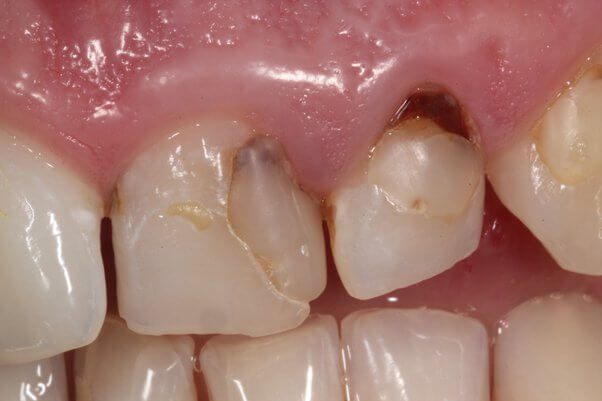
Cost of Dental Pulp Capping
The cost of Dental Pulp Capping, whether it is done using a direct or indirect technique, is the same as the cost of a dental filling.
Whether it is an amalgam filling, composite resin filling, or glass ionomer filling, the cost of any of these Dental Fillings are similar and will depend on the location of the tooth (anterior, bicuspid or molar), as well as the size of the filling, which is translated as the number of “surfaces” involved. Imagine each tooth as a 5 surface box. Each “surface” that gets incorporated will dictate the size (and overall cost) of the tooth filling. Therefore, the cost of a filling can range between $200-460. The codes relevant to dental fillings in the Ontario Dental Association’s Suggested Fee Guide appear as follows:
Permanent Anteriors:
- 23111 – One surface: $200
- 23112 – Two surfaces: $250
- 23113 – Three surfaces: $300
- 23114 – Four surfaces: $370
- 23115 – Five surfaces (maximum surfaces per tooth): $390
Permanent Bicuspids:
- 23311 – One surface: $220
- 23312 – Two surfaces: $275
- 23313 – Three surfaces: $330
- 23314 – Four surfaces: $400
- 23315 – Five surfaces or maximum surfaces per tooth: $420
Permanent Molars:
- 23321 – One surface: $240
- 23322 – Two surfaces: $300
- 23323 – Three surfaces: $360
- 23324 – Four surfaces: $440
- 23325 – Five surfaces or maximum surfaces per tooth: $460
Dental Fillings are considered a basic service under all dental insurance plans and should be covered to your maximum insurable limit, but be sure to find out from your dental insurance plan provider how much you are eligible for before going ahead with dental treatment. Our fees are consistent with the ODA Fee Guide.
For patients without dental insurance, Atlas Dental is pleased to offer dental financing through Dentalcard. Affordable payment plans start at 7.95% for terms of 6 months to 6 years. To learn more about Dentalcard dental treatment financing, follow this link.
What Are The Steps In The Indirect Pulp Capping Procedure?
Indirect Pulp Capping is a dental procedure performed to preserve and protect a tooth’s dental pulp when it’s been affected by decay or damage but hasn’t reached an advanced stage of infection. The procedure involves specific steps to ensure the dental pulp’s health and prevent further complications. Here’s an overview of the typical steps involved in Indirect Pulp Capping:
- Dental Examination: The process begins with a thorough dental examination. Your dentist will evaluate the affected tooth’s condition, including the extent of decay or damage and the overall health of the dental pulp. X-rays may be taken to get a more detailed view of the tooth’s interior.
- Local Anesthesia: To ensure your comfort throughout the procedure, your dentist will administer a local anesthetic to numb the area around the affected tooth. This will prevent you from feeling any pain or discomfort during the treatment.
- Tooth Isolation: To maintain a sterile field and keep the tooth dry, your dentist will use a rubber dam to isolate the affected tooth. This small, flexible sheet is placed around the tooth and anchored with clips, ensuring saliva and moisture do not interfere with the procedure.
- Removal of Decay: If there is any decay or damaged tooth structure, your dentist will carefully remove it using specialized dental instruments. This step is essential to eliminate the source of the dental problem and create a clean environment for the pulp capping.
- Application of Protective Material: Once the decay is removed and the tooth is prepared, your dentist will apply a protective dental material over the exposed dental pulp. This material is often a biocompatible substance designed to stimulate the pulp’s natural healing and provide a barrier against bacteria, such as a calcium hydroxide paste or mineral trioxide aggregate (MTA).
- Sealing the Tooth: After the protective material is placed, your dentist will seal the tooth using a restorative material, such as a dental filling or dental crown. The choice of material will depend on the extent of tooth structure removed and the tooth’s location in your mouth.
- Final Adjustments: Your dentist will make any necessary adjustments to ensure the tooth’s proper function and alignment with your other teeth. This may involve shaping the dental filling or crown to fit your bite comfortably.
- Post-Procedure Care: Your dentist will provide you with tooth filling post-procedure care instructions, which typically include guidelines on oral hygiene, dietary restrictions, and what to expect during the healing process. It’s crucial to follow these instructions to maximize the success of the procedure. Depending on your dentist’s recommendations and your tooth’s response to the procedure, you may need to schedule follow-up appointments to monitor the tooth’s health and make any necessary adjustments.
Indirect Pulp Capping is a minimally invasive procedure designed to save your natural tooth and protect the dental pulp. While it’s generally a safe and effective treatment, success depends on various factors, including early detection, appropriate patient selection, and proper post-procedure care. If you’re a candidate for this procedure, consult with your dentist to discuss the specific steps and expectations for your case. If you have further questions about Indirect Pulp Capping, please contact us.
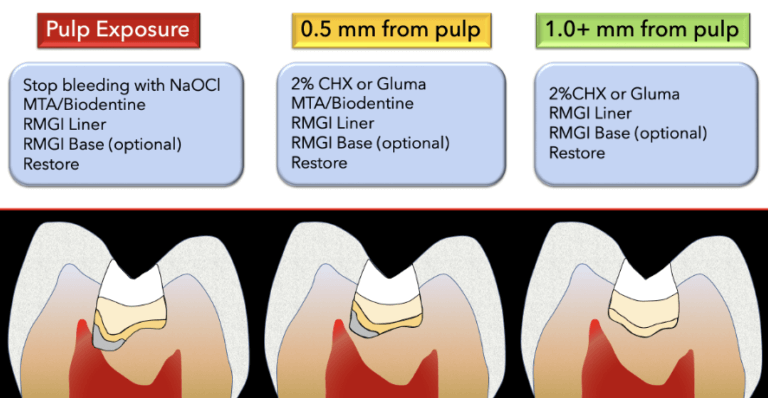
Can I Have Indirect Pulp Capping If I Am Pregnant?
The decision to undergo dental procedures, including Indirect Pulp Capping, during pregnancy should be made carefully, considering the potential risks and benefits to both the mother and the developing fetus. Dental health is important during pregnancy, as hormonal changes can increase the risk of dental issues. Here are some considerations regarding Indirect Pulp Capping during pregnancy:
- Timing of the Procedure: Ideally, elective dental procedures, including Indirect Pulp Capping, should be postponed until after the first trimester of pregnancy. This is the period when the developing fetus is most vulnerable to potential risks.
- Local Anesthesia: Local anesthesia used during dental procedures is generally considered safe during pregnancy when administered in appropriate doses. Your dentist will use the smallest effective dose to ensure your comfort while minimizing potential risks to the baby.
- Radiation Exposure: Dental X-rays are typically avoided during pregnancy, especially during the first trimester, unless they are absolutely necessary. If X-rays are required for your dental evaluation, your dentist will take precautions to minimize radiation exposure to the developing fetus.
- Medications: It’s essential to inform your dentist if you are pregnant or trying to conceive, as some medications and materials used in dental procedures may not be recommended during pregnancy. Your dentist will select materials and medications that are safe for pregnant women when performing Indirect Pulp Capping.
- Consultation with Healthcare Provider: Before undergoing Indirect Pulp Capping or any dental procedure during pregnancy, it’s advisable to consult with your obstetrician or healthcare provider. They can provide guidance specific to your pregnancy, overall health, and any underlying medical conditions.
It’s essential to prioritize oral health during pregnancy, as poor dental health can lead to complications such as gum disease and dental infections, which may affect both maternal and fetal health. Maintaining good oral hygiene practices, including regular brushing, flossing, and dental check-ups, is crucial during this time. If you have further questions about Indirect Pulp Capping, please contact us.
What Are Common Problems With Indirect Pulp Capping?
Indirect Pulp Capping is a dental procedure designed to preserve the dental pulp and save a tooth from further decay or damage. While it is generally considered a safe and effective treatment, there can be certain problems or challenges that patients may encounter. Here are some common issues associated with Indirect Pulp Capping:
- Incomplete Resolution of Dental Decay: One of the primary goals of Indirect Pulp Capping is to stop the progression of dental decay. However, in some cases, the procedure may not fully resolve the decay, leading to continued deterioration of the tooth over time.
- Pulpal Infection: Despite attempts to protect the dental pulp, there is a risk of infection if the pulp has already been compromised by bacteria or if the protective materials fail to create an effective seal. In such cases, additional treatment, such as a root canal, may be necessary.
- Tooth Fracture: Indirect Pulp Capping involves the removal of decayed or damaged tooth structure. This can weaken the tooth, increasing the risk of fractures or breaks, especially if the tooth is subjected to excessive force or pressure.
- Pulpal Necrosis: In some instances, the dental pulp may not heal as expected, leading to pulp necrosis (the pulp becomes non-vital). This can result in persistent pain or discomfort, necessitating further dental intervention.
- Post-Procedure Discomfort: Some patients may experience temporary discomfort, sensitivity, or pain following Indirect Pulp Capping. This is typically mild and short-lived but should be discussed with your dentist if it persists.
It’s important to note that while these problems are possible, they are relatively rare when Indirect Pulp Capping is performed by a skilled and experienced dentist. Success rates for this procedure are generally high, especially when used in appropriate cases where the dental pulp is not severely compromised. If you have further questions about Indirect Pulp Capping, please contact us.
We also think you’ll like…
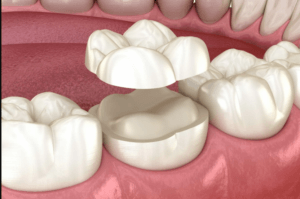
Porcelain Onlay Recementation
Porcelain Onlay Recementation What Is Dental Onlay Recementation? A Porcelain Onlay is a type of dental restoration that is used to repair a damaged or
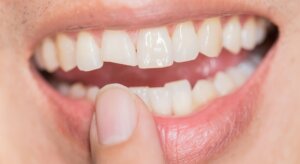
Broken Tooth
Broken Tooth What Is A Broken Tooth? A Broken Tooth refers to a tooth that has been cracked, fractured or chipped. It can be caused
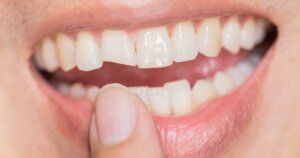
Cracked, Chipped or Broken Tooth
How To Fix My Cracked, Chipped or Broken Tooth Help! I Have A Broken Tooth And Don’t Know What To Do! If a piece of

Porcelain Onlay
Porcelain Onlay What Is A Porcelain Onlay? A Porcelain Onlay is a type of dental restoration that is used to repair a damaged or decayed
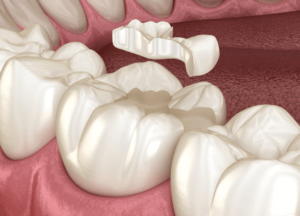
Porcelain Inlay
Porcelain Inlay What Is A Porcelain Inlay? A Porcelain Inlay is a type of dental restoration crafted from high-quality, biocompatible porcelain material. These restorations are
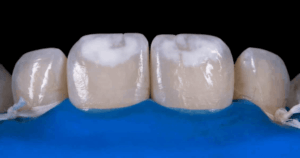
White Spot Lesions
White Spot Lesions What Are White Spot Lesions? White spot lesions, also known as enamel decalcifications, are common dental conditions characterized by chalky white patches

